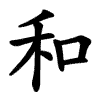和
| ||||||||
Translingual
| Stroke order | |||
|---|---|---|---|
| Stroke order | |||
|---|---|---|---|
 | |||
Han character
和 (Kangxi radical 30, 口+5, 8 strokes, cangjie input 竹木口 (HDR), four-corner 26900, composition ⿰禾口)
Descendants
- わ (Hiragana character derived from Man'yōgana)
- ワ (Katakana character derived from Man'yōgana)
References
- KangXi: page 185, character 1
- Dai Kanwa Jiten: character 3490
- Dae Jaweon: page 404, character 3
- Hanyu Da Zidian (first edition): volume 1, page 602, character 1
- Unihan data for U+548C
Chinese
| simp. and trad. |
和 | |
|---|---|---|
| alternative forms | 咊 龢 訸/𰵝 | |
Glyph origin
| Historical forms of the character 和 | |||
|---|---|---|---|
| Western Zhou | Warring States | Shuowen Jiezi (compiled in Han) | |
| Bronze inscriptions | Chu slip and silk script | Qin slip script | Small seal script |
 |
 |
 |
 |
Phono-semantic compound (形聲/形声, OC *ɡoːl, *ɡoːls) : phonetic 禾 (OC *ɡoːl) + semantic 口 (“mouth”) – harmony.
Etymology
(This etymology is missing or incomplete. Please add to it, or discuss it at the Etymology scriptorium. Particularly: “see talk”)
Pronunciation 1
Definitions
和
- peaceful; harmonious
- 和平 ― hépíng ― peace, peaceful
- gentle; kind
- warm; temperate
- sum; total
- to make peace; to become reconciled
- 子曰:君子和而不同,小人同而不和 [Classical Chinese, trad. and simp.]
- From: The Analects of Confucius, c. 475 – 221 BCE, translated based on James Legge's version
- zǐ yuē: jūnzǐ hé ér bù tóng, xiǎorén tóng ér bù hé [Pinyin]
- The Master said, "The superior man is affable, but not adulatory; the mean man is adulatory, but not affable."
- (chess) to tie
- (music) An ancient mouth organ similar to the sheng, but smaller; no longer used.
- Japanese
- 和服 ― héfú ― kimono, Japanese traditional clothing
- a surname. He
Compounds
|
|
|
Descendants
- → Thai: ฮั้ว (húua)
Pronunciation 2
Synonyms
Pronunciation 3
Definitions
和
Compounds
Pronunciation 4
Definitions
和
Pronunciation 5
Definitions
和
Compounds
Usage notes
- When playing mahjong, a player may say this word as a call when winning from another player's discard.
See also
- Japanese: 和了 (hōra)
Pronunciation 7
References
- “和”, in 漢語多功能字庫 (Multi-function Chinese Character Database), 香港中文大學/香港中文大学 (the Chinese University of Hong Kong), 2014–
Japanese
Readings
- Go-on: わ (wa, Jōyō)
- Kan-on: か (ka)←くわ (kwa, historical)
- Tō-on: お (o, Jōyō †)←を (wo, historical)
- Kun: あえる (aeru, 和える); なごむ (nagomu, 和む, Jōyō); なごやか (nagoyaka, 和やか, Jōyō); やわらぐ (yawaragu, 和らぐ, Jōyō)←やはらぐ (yafaragu, historical); やわらげる (yawarageru, 和らげる, Jōyō)←やはらげる (yafarageru, historical)
- Nanori: あい (ai); いず (izu); かつ (katsu); かづ (kazu); かつり (katsuri); かず (kazu); たけ (take); ち (chi); とも (tomo); な (na); にぎ (nigi); まさ (masa); やす (yasu); よし (yoshi); より (yori); わだこ (wadako); わっ (wa')
Compounds
- 和尚 (oshō)
- 柔和 (nyūwa): gentleness, meekness, mildness
- 和韻 (wain)
- 和英 (waei)
- 和歌 (waka)
- 和解 (wakai)
- 和学 (wagaku)
- 和菓子 (wagashi)
- 和漢 (wakan)
- 和姦 (wakan)
- 和漢混交文 (wakan konkō bun)
- 和気 (waki)
- 和気藹 (wakiai)
- 和気藹藹 (wakiaiai)
- 和議 (wagi)
- 和協 (wakyō)
- 和訓 (wakun)
- 和敬 (wakei)
- 和敬静寂 (wakei seijaku)
- 和語 (wago)
- 和寇 (wakō)
- 和合 (wagō)
- 和光同塵 (wakō dōjin)
- 和琴 (wakin)
- 和魂漢才 (wakon kansai)
- 和裁 (wasai)
- 和算 (wasan)
- 和紙 (washi)
- 和字 (waji)
- 和室 (washitsu)
- 和同 (wadō)
- 和習 (washū)
- 和順 (wajun)
- 和書 (washo)
- 和上 (wajō)
- 和食 (washoku)
- 和製 (wasei)
- 和戦 (wasen)
- 和風 (wafū)
- 和服 (wafuku)
- 和文 (wabun)
- 和平 (wahei)
- 和睦 (waboku)
- 和本 (wahon)
- 和名 (wamei)
- 和訳 (wayaku)
- 和洋 (wayō)
- 和洋折衷 (wayō sechū)
- 和様 (wayō)
- 和学 (wagaku)
- 漢和辞典 (kanwa jiten)
- 緩和 (kanwa)
- 講和 (kōwa)
- 昭和 (shōwa)
- 唱和 (shōwa)
- 総和 (sōwa)
- 調和 (chōwa)
- 飽和 (hōwa)
- 令和 (reiwa): a new era name, effective on the 1st of May, 2019
- 大和 (Yamato)
Etymology 1
| Kanji in this term |
|---|
| 和 |
| わ Grade: 3 |
| on’yomi |
From Middle Chinese 和 (hwa, “harmonious”).
The “Japan” sense appears during the reign of Empress Genmei (707–715), as this character 和 was chosen as a homophone with a more favorable meaning to replace the previous character 倭 (Wa) then in use as the kanji name for Japan[1] (see the etymology at 大和 (Yamato) for more details). The “Japan” sense was usually read with a kun'yomi of yamato, until some time in the Muromachi period, when the go'on reading of Wa became more common.[2]
Affix
和 • (wa)
Etymology 2
| Kanji in this term |
|---|
| 和 |
| やまと Grade: 3 |
| kun’yomi |
See Etymology 1.
In modern Japanese, the Yamato reading is more commonly spelled 大和.
Definitions
| For pronunciation and definitions of 和 – see the following entry. | ||
| ||
| (This term, 和, is an alternative spelling of the above term.) |
Etymology 3
| Kanji in this term |
|---|
| 和 |
| のど Grade: 3 |
| kun’yomi |
Definitions
| For pronunciation and definitions of 和 – see the following entry. | ||
| ||
| (This term, 和, is an alternative spelling of the above term.) |
Korean
Etymology
From Middle Chinese 和 (MC ɦuɑ).
Compounds
- 화평 (和平, hwapyeong)
- 평화 (平和, pyeonghwa, “peace”)
- 조화 (調和, johwa, “harmony; balance”)
- 화해 (和解, hwahae, “reconciliation”)
- 화목 (和睦, hwamok, “harmoniousness”)
- 화합 (和合, hwahap, “harmony; cohesion”)
- 유화 (柔和, yuhwa, “gentle”)
- 친화 (親和, chinhwa, “friendliness”)
- 화음 (和音, hwa'eum, “chord”)
- 포화 (飽和, pohwa, “saturation”)
- 불화 (不和, bulhwa, “disharmony”)
- 공화국 (共和國, gonghwaguk, “republic”)
- 공화당 (共和黨, gonghwadang, “republican party”)
- 공화주의 (共和主義, gonghwajuui, “republicanism”)
- 중화인민공화국 (中華人民共和國, junghwainmin'gonghwaguk)
Vietnamese
References
- Nguyễn et al. (2009).
- Trần (1999).
- Trần (2004).
- Hồ (1976).